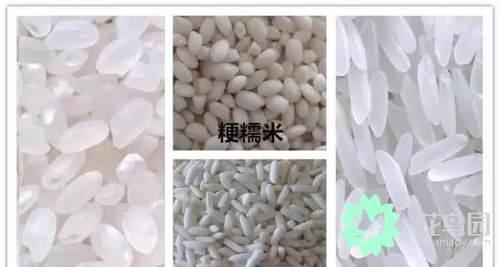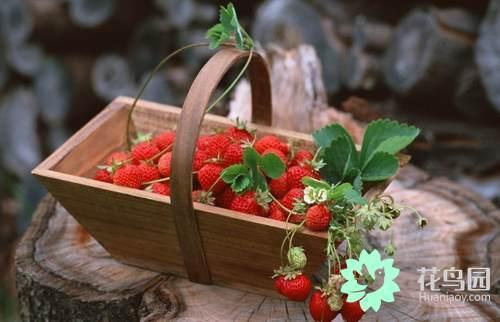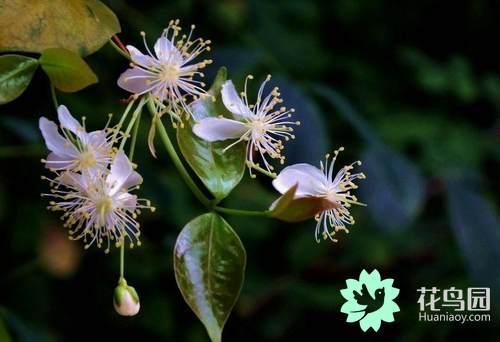Cold knowledge: japonica rice, purple rice, fragrant rice, rice, millet. The article explains all kinds of rice clearly.

Rice is one of the three staple foods in the world, especially in East Asia, where many people eat rice every day. Rice originated in China and spread all over the world, so far there are tens of thousands of different varieties. In order to improve the quality, breeders continue to cultivate new varieties.
In the supermarket, we can see all kinds of rice, such as japonica rice, indica rice, brown rice, black rice, fragrant rice. What is the difference between these kinds of rice?
In fact, these names come from different classification bases, which are described below.
Indica rice, japonica rice and glutinous rice
The main component of rice is starch. According to the connection mode of glucose monomer in starch molecule, starch is divided into two categories: "amylopectin" and "amylose".
Amylose is like a long thread, while amylopectin is like a big tree with branches, branches and small branches.
The molecular size of amylose is smaller than that of amylopectin and can form a tight structure. The molecules of amylopectin are relatively less entangled, while the molecules of amylopectin are large and easy to involve each other.
The content of amylose in different rice varies greatly, the high one is more than 20%, and the low one is almost zero.
Generally speaking, indica rice has a slender shape and high amylose content, and the cooked rice is well-defined and does not adhere to each other. Because the amylose content is high, the digestion rate is slower, and the glycemic index is relatively lower. In foreign countries, it is roughly equivalent to "long grain rice" (long grain).
The shape of japonica rice is shorter, the content of amylose is low, the elasticity of cooked rice is better than that of indica rice, and there is a certain adhesion between grains. Abroad, it is equivalent to "medium grain rice" (medium grain) and "short grain rice" (short grain). Northeast rice in China, rice used to make sushi in Japan, is usually japonica rice.
Glutinous rice is usually short round, and there are also some long ones. It is characterized by extremely low amylose content, almost entirely amylopectin. The light transmittance of raw rice of indica rice and japonica rice is better, while glutinous rice is as white as milk and very sticky and soft when cooked. In different places, glutinous rice is also called "sticky rice" and "Jiangmi".
Brown rice and milled rice
Brown rice and milled rice are divided according to the degree of processing, which are called "brown rice" and "white rice" respectively in foreign countries.
Brown rice is the product of rice after removing the husk. The surface of brown rice also has a layer of skin, which contains a lot of fiber, which affects the taste. Remove this layer of fiber and you get milled rice, or white rice. The removal of this layer generally accounts for about 7% of the total weight of brown rice, which is called "rice bran".
Rice bran contains more dietary fiber, vitamins and minerals, as well as rich antioxidants, as well as a high content of oil. These oils are mainly unsaturated fats and can be regarded as "healthy" oils compared with animal oils.
Because of this layer of rice bran, brown rice contains more nutrients that modern people are easy to lack, and the glycemic index is lower. So, generally speaking, brown rice is healthier than milled rice. Of course, brown rice tastes obviously worse than milled rice.
Early, middle and late rice
According to the difference of sowing time, growing period and mature period, rice can be divided into three types: early rice, middle rice and late rice. The shortest growing period of early rice is only 90 days, while the longest of late rice is 170 days. Different growth periods may have a certain impact on the taste of rice. Generally speaking, the taste of early rice is not as good as that of medium and late rice.
Single cropping, two cropping, three cropping, ratooning rice
Single-cropping rice, two-cropping rice and three-cropping rice refer to the rice that can be planted one, two and three crops in a year, respectively. It depends not only on the variety of rice, but also on the climate of the growing area. Ratooning rice is a kind of rice which is planted once and harvested once, and then harvested again by using the remaining roots and stems. Ratooning rice is the result of the comprehensive effect of variety, climate and planting technology.
Generally speaking, these classifications are mainly related to production and have a certain impact on the taste of rice, but there is no difference in nutritional value.
The taste of rice will also be affected by many other factors (the next article will describe in detail what factors will affect the taste, taste and aroma of rice). It is most appropriate for consumers to buy rice directly. There is no need to worry about how it is produced.
Black rice and purple rice
Black rice and purple rice are named because of their color. They themselves may be japonica rice or indica rice.
They are special varieties selected and there are a lot of anthocyanins on the surface of rice. Because the specific types and contents of anthocyanins are different, some are black and some are purple. Anthocyanins are water-soluble, so soaking in water will cause "discoloration". According to the acidity and basicity of the water, the color will change to a certain extent.
Anthocyanins are famous antioxidants, and many "healthy foods" are sold with antioxidants, so black and purple rice are also regarded as "healthy foods", making them more expensive. There may be illegal traders dyeing with pigments in the market, and many people regard discoloration in the water as the identification standard of "fake black rice" and "fake purple rice". But as introduced above, in fact, real black rice and purple rice will also fade.
However, the color dyed out is different from that of black rice and purple rice. Real black rice and purple rice, the color becomes lighter from the outside to the inside, kneading in water will fade, but the color of rice will only fade.
And the color dyed out, if the color is also water-soluble pigment, then the rice grain may become white after discoloration; if it is oily pigment, it is not easy to fade, after rubbing hard, the color on the rice grain may appear uneven white spots.
Rice and millet
In plant classification, all kinds of rice are "blood relatives" of the same genus and species, which belong to the same species of Gramineae rice.
While millet belongs to the genus Equisetum of Gramineae, it is not under the same roof as rice at the "genus" level. Millet has a longer history in China. The ancients called it "millet" and the plant was called "he".
In modern times, the north calls it "millet" and the grain produced is called millet. In Sichuan and other places, "millet" refers to rice and rice. Millet has higher levels of vitamins and minerals than rice.
Fragrant rice
Fragrant rice is named according to its flavor characteristics, and it is more of a traditional and customary naming. Whether it is indica rice, japonica rice or glutinous rice, there are varieties called "fragrant rice".
Chen Mi and Xinmi
Everyone hates Chen rice and likes new rice, hoping to have a way to "distinguish Chen rice". In theory, with the extension of preservation time, the luster and aroma of rice will decline, and the cooked rice will be inferior in taste and flavor.
But as long as there is no mildew and deterioration, there will be no change in starch, protein and minerals; some kinds of vitamins will decline, but rice itself is not a major source of vitamins, so the effect on nutrition is not great.
If the preservation condition of aged rice is not good, which leads to mildew, it may lead to an increase in the content of aflatoxin. So even if you put moldy Chen rice on your own, it's best not to eat it.
The luster and aroma of rice are not only affected by the preservation time, but also have a lot to do with the variety of rice. If it is the same kind of rice, put the fresh and the old together, then it may not be difficult to tell: the bright luster and fragrance is the fresh rice; the glossy, unscented or even moldy rice is the old rice.
If it is not such a "contrast", then according to its appearance and aroma and other sensory standards, it is difficult to judge how long it has been stored. Moreover, the speed of rice "aging" in storage, time is only one aspect, preservation conditions are also important. Even if it is preserved for the same time, some rice will be "very old" under different preservation conditions, while some rice may be "like new rice".
For consumers, it is important to see whether the appearance and aroma of rice are satisfactory, rather than worrying about whether it is "new" or "old". Of course, if the packaged rice is purchased through standardized channels, the production date will be marked.
Although this production date refers to the date on which rice is produced for packaging, rather than the date of harvest, rice with a newer production date is generally more "newer".
- Prev

If you eat too many strawberries, will you vomit and be poisoned? Can strawberries be eaten or not?
Strawberries belong to berry fruits, its family is very large, such as raspberries, cranberries, red berries, blueberries, purple berries and so on, are the brothers and sisters of strawberries, taste is very attractive, so compare quality and cheap.
- Next

How to cultivate red fruit with both good appearance and delicacy?
Red fruit is the myrtle family, cherry genus, shrubs or small trees, alias: Brazilian red fruit, sakura, Prunus chinensis. Native to Brazil, there is a small amount of cultivation in the south of China. Red fruit has a beautiful tree shape, dark green leaves, and is common in the four seasons.
Related
- Wuhan Hospital Iron Tree Blooming Result Was Instantly Frightened by the Gardener Master
- Which variety of camellia is the most fragrant and best? Which one do you like best?
- What is the small blue coat, the breeding methods and matters needing attention of the succulent plant
- Dormancy time and maintenance management of succulent plants during dormancy
- Minas succulent how to raise, Minas succulent plant pictures
- What are the varieties of winter succulent plants
- How to raise succulent plants in twelve rolls? let's take a look at some experience of breeding twelve rolls.
- Attention should be paid to water control for succulent plants during dormant period (winter and summer)
- Watering experience of twelve rolls of succulent plants
- Techniques for fertilizing succulent plants. An article will let you know how to fertilize succulent plants.

